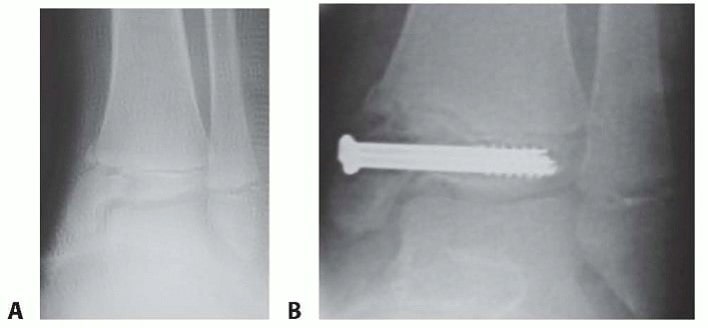Fixing Tillaux Triplane Medial Malleolar Fractures: Insights and Techniques
Discover the various fixation techniques, including screw placements and alignment procedures, for addressing Tillaux, Triplane, and Medial Malleolar fractures, ensuring proper treatment and alignment restoration."
Tillaux Triplane Medial Malleolar Fractures
Tillaux Fractures: Salter-Harris Type III Fractures
A surgical approach to the ankle from the front and side is used.
This type of fracture can be fixed by placing a screw across the fracture site, from the lower end to the upper end, and from the front to the back.

Alternatively, if the surgeon prefers, cannulated screws can be used instead of noncannulated screws.
It is safe to cross the growth plate in this type of fracture because, by definition, the inner part of the growth plate is closed and complete closure of the growth plate is about to happen.
Medial Malleolar Fractures: Salter-Harris Types III and IV Fractures
If there is only a small fragment in the metaphysis, these fractures can be fixed using 4.0-mm screws or Kirschner wires that are fully within the epiphysis, in line with the growth plate and joint.

If the fracture can be corrected without surgery, these fractures can be treated using a minimally invasive procedure. However, a small incision can be made to directly see the correction and the joint surface.
If there is a larger fragment in the metaphysis, another screw can be placed parallel to the growth plate, in addition to the screw in the epiphysis.
If the patient is still growing and the fracture cannot be fixed with screws in the epiphysis, Kirschner wires can be placed across the fracture site and growth plate, which will be removed later.
If the patient is almost done growing, these fractures can be treated like adult fractures, using two partially threaded cannulated or noncannulated screws placed at a right angle to the fracture site.
Alternatively, in patients who are close to skeletal maturity, compression across the fracture and apophysis can be achieved using two Kirschner wires that are compressed with a tension band wire loop.
In some cases, it has been suggested to remove and dispose of the metaphyseal fragment to get a better view of the growth plate and prevent bone bridging in that area. However, this approach is not recommended.
If it is necessary to remove this piece of bone, it will be replaced once the alignment is restored and the growth plate is cleared of any mechanical obstructions without causing any harm.
Triplane Fractures: Salter-Harris Type IV Fractures
Triplane fractures are complex fractures that involve the lower part of the tibial growth plate when it is closing in an uneven manner during early teenage years.
Because of their complexity, we suggest using CT scans with three-dimensional images for preoperative planning.
The surgical approach depends on the complexity of the fracture, as these fractures can be divided into two, three, or four parts.

Two-part fractures and sometimes three-part fractures can be realigned and fixed using a surgical approach that only involves the front and side of the ankle joint.
Generally, screws should be placed in both the joint and the bone, and it may be beneficial to use two incisions to achieve realignment and better access to the fracture fixation.
The front incision is used to align and fix the piece in the bone, often in a vertical plane, and to see the joint surface.
The inner incision allows for the insertion of the screw in the joint.
Both incisions will provide a direct view of the fracture realignment.
If the fibula is significantly fractured and shortened, it is important to align the fibula correctly, with or without fixation, to have a proper reference for the normal length of the ankle joint.
from the lower end to the upper end
and from the front to the back

instead of noncannulated screws
of fracture due to closed inner part
and complete closure approaching
or Kirschner wires within epiphysis
in line with growth plate and joint
small incision for correction and
directly seeing joint surface
plate and screw in epiphysis
site and growth plate if required
cannulated or noncannulated screws
Kirschner wires and tension band
wire loop if close to skeletal maturity
as the goal is to restore alignment
without causing harm
is restored and growth plate is cleared

and realignment of the fracture
and observe joint surface
of normal ankle joint length

